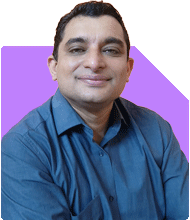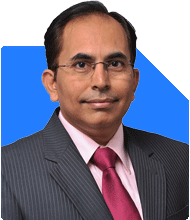Ramalingam Kalirajan |10902 Answers |Ask -Follow
Mutual Funds, Financial Planning Expert - Answered on May 15, 2024
He has an MBA in finance from the University of Madras and is a certified financial planner.
He is the director and chief financial planner at Holistic Investment, a Chennai-based firm that offers financial planning and wealth management advice.... more

Hi Sir, I'm 43+, Monthly take home is around 3.20 Lacs, Currently i have invested in Shares (Current Portfolio is around 1.55 Crs). EMI is around 1.1 lacs P/m, Recently i have started investing in SIP 1 lacs P/M, and balance 1.20 lacs goes in house, kids education expense. Have EPF balance of 40 lacs as on date. As mentioned above recently i have started investing in SIP (From Oct 2023 onwards), which is at the tune of 1 lacs per month. SIP are Franklin India Prima Fund regular Plan - Growth - 25K, ICICI Prudential Small cap fund retail plan G - 25K, Kotak Multicap fund regular plan growth - 15K, DSP Blackrock mid cap fund regular plan growth - 10 K, and Parag Parikh Flexi Cap fund - Regular plan growth - 25 K. Will increase the SIP investment by 10% every year going forward. Sir, My question is with current SIP investment will i be able to generate 8~10 Cr corpus fund by retirement (Assuming that i will be in Job and working for next 15 years). Current Share portfolio is for long term investment only (assuming i get 12~15% of return every year).
Considering your current financial situation and investment strategy, let's evaluate whether your SIP investments can help you achieve a corpus of 8-10 crores by retirement in the next 15 years.
Assessment of Current Investments
Shares Portfolio: With a current portfolio value of 1.55 crores and assuming an annual return of 12-15%, your shares portfolio has the potential to grow significantly over the long term.
EPF Balance: Your EPF balance of 40 lakhs provides a solid foundation for retirement savings and adds to your overall retirement corpus.
SIP Investments: Your SIP investments totaling 1 lakh per month are diversified across various mutual funds, including Franklin India Prima Fund, ICICI Prudential Small Cap Fund, Kotak Multicap Fund, DSP Blackrock Mid Cap Fund, and Parag Parikh Flexi Cap Fund. The plan to increase SIP investments by 10% annually demonstrates a commitment to long-term wealth accumulation.
Estimation of Future Corpus
To estimate the potential corpus accumulated through SIP investments, let's assume an average annual return of 12% over the next 15 years. With an initial SIP investment of 1 lakh per month and an annual increase of 10%, the future value of SIP investments can be calculated using a future value of annuity formula.
Considering the monthly SIP investments and their projected growth, you can accumulate a substantial corpus over the next 15 years. However, the final corpus will depend on various factors such as market performance, investment discipline, and economic conditions.
Assessment of Retirement Corpus Target
Achieving a corpus of 8-10 crores by retirement is ambitious but feasible with consistent savings, prudent investment decisions, and disciplined portfolio management. Your combined investments in shares, EPF, and SIPs demonstrate a proactive approach towards building wealth for retirement.
Recommendations
Regular Monitoring: Continuously monitor the performance of your SIP investments and shares portfolio. Periodically review your financial goals and adjust your investment strategy as needed to stay on track towards achieving your retirement corpus target.
Risk Management: Diversify your investment portfolio to manage risk effectively. Consider allocating assets across different asset classes such as equities, debt, and real estate to enhance portfolio resilience.
Professional Guidance: Consult with a Certified Financial Planner (CFP) to develop a comprehensive financial plan tailored to your specific needs, goals, and risk tolerance. A financial advisor can provide personalized recommendations and strategies to optimize your investment portfolio for long-term wealth accumulation.
With a disciplined approach to savings and investments, coupled with prudent financial planning, you can work towards achieving your retirement goals and securing a comfortable financial future for yourself and your family.
Best Regards,
K. Ramalingam, MBA, CFP,
Chief Financial Planner,
www.holisticinvestment.in
You may like to see similar questions and answers below
Ramalingam Kalirajan |10902 Answers |Ask -Follow
Mutual Funds, Financial Planning Expert - Answered on Jul 15, 2024
Ramalingam Kalirajan |10902 Answers |Ask -Follow
Mutual Funds, Financial Planning Expert - Answered on Jul 25, 2024
Ramalingam Kalirajan |10902 Answers |Ask -Follow
Mutual Funds, Financial Planning Expert - Answered on Oct 01, 2024
Milind Vadjikar | Answer |Ask -Follow
Insurance, Stocks, MF, PF Expert - Answered on Nov 15, 2024
Anu Krishna |1749 Answers |Ask -Follow
Relationships Expert, Mind Coach - Answered on Dec 17, 2025
Anu Krishna |1749 Answers |Ask -Follow
Relationships Expert, Mind Coach - Answered on Dec 17, 2025
Radheshyam Zanwar |6748 Answers |Ask -Follow
MHT-CET, IIT-JEE, NEET-UG Expert - Answered on Dec 17, 2025
Anu Krishna |1749 Answers |Ask -Follow
Relationships Expert, Mind Coach - Answered on Dec 17, 2025
Dr Shakeeb Ahmed Khan |184 Answers |Ask -Follow
Physiotherapist - Answered on Dec 17, 2025
T S Khurana |538 Answers |Ask -Follow
Tax Expert - Answered on Dec 17, 2025
T S Khurana |538 Answers |Ask -Follow
Tax Expert - Answered on Dec 17, 2025
Janak Patel |72 Answers |Ask -Follow
MF, PF Expert - Answered on Dec 17, 2025
Ramalingam Kalirajan |10902 Answers |Ask -Follow
Mutual Funds, Financial Planning Expert - Answered on Dec 17, 2025
Samraat Jadhav |2511 Answers |Ask -Follow
Stock Market Expert - Answered on Dec 17, 2025




























